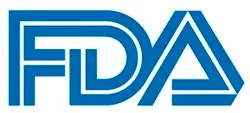News
Article
FDA Grants Breakthrough Therapy Designation to NVL-520 for Metastatic ROS1+ NSCLC
Author(s):
The FDA has granted breakthrough therapy designation to NVL-520 for pretreated, metastatic ROS1-positive non–small cell lung cancer.
US FDA

The FDA has granted breakthrough therapy designation to NVL-520 for the treatment of patients with metastatic ROS1-positive non–small cell lung cancer (NSCLC) who previously received at least 2 ROS1 TKIs.1
The novel, brain-penetrant, ROS1-selective inhibitor is currently under investigation in patients with advanced NSCLC and other ROS1-positive solid tumors in the phase 1/2 ARROS-1 trial (NCT05118789).
Previously reported data from the phase 1, dose-escalation portion of the study demonstrated that in all evaluable patients (n = 35), no dose-limiting toxicities, serious treatment-related adverse effects (AEs), treatment-emergent dizziness, or AEs leading to treatment reductions or discontinuations occurred.2
Patients with heavily pretreated NSCLC evaluable for efficacy (n = 21) experienced a partial response rate of 48%.
“In line with our commitment to bringing new potential best-in-class medicines to patients with cancer as quickly as possible, we are always looking for opportunities to further accelerate our programs," James Porter, PhD, CEO of Nuvalent, said in a press release.1 "We're very encouraged by today's announcement of FDA breakthrough therapy designation for NVL-520, as it recognizes the continued need for innovation for patients with ROS1-positive NSCLC who have exhausted available therapies. We look forward to providing an update from the ARROS-1 trial of NVL-520 at a medical meeting later this year.”
The open-label, nonrandomized ARROS-1 trial is enrolling adult patients, except for cohort 2e, which allows the enrollment of those at least 12 years of age and more than 40 kg in body weight. In the phase 1, dose-escalation portion of the study, patients needed to have histologically or cytologically confirmed locally advanced or metastatic solid tumors with ROS1 rearrangements. In phase 2, cohorts 2a, 2b, 2c, and 2d include those with histologically or cytologically confirmed locally advanced or metastatic NSCLC harboring a ROS1 rearrangement. Cohort 2e features patients with histologically or cytologically confirmed locally advanced or metastatic, ROS1-positive solid tumors other than NSCLC. Prior anticancer treatment is required, except for patients in cohort 2a, and all patients must have adequate baseline organ function and bone marrow reserve.3
Patients are excluded if they have an oncogenic driver alteration other than ROS1 or underwent major surgery within 4 weeks of first dose of study drug.
In phase 1, patients received once-daily doses of NVL-520 ranging from 25 mg to 150 mg.2 The recommended phase 2 dose (RP2D) was established at 100 mg once per day.4
The primary end points in phase 1 were determining the maximum tolerated dose and the RP2D. Objective response rate is serving as phase 2’s primary end point.3
In phase 1, most of the overall patient population received at least 3 prior lines of anti-cancer therapy (77%); 2 or more ROS1 TKIs and 1 or more lines of chemotherapy (71%); and a ROS1 TKI other than crizotinib (Xalkori) or entrectinib (Rozlytrek; 80%). Other prior ROS1 TKIs included lorlatinib (Lorbrena; 57%) and repotrectinib (Augtyro; 34%).2
Additional efficacy data from phase 1 showed that activity was observed in subgroups of patients with NSCLC. Patients with ROS1 G2032R mutations (n = 9) achieved an ORR of 78%; Those with a history of central nervous system metastases (n = 11) had an ORR of 73%. The ORR for patients who received 2 or more prior ROS1 TKIs and 1 or more prior lines of chemotherapy (n = 17) was 53%, and those previously treated with lorlatinib or repotrectinib (n = 18) experienced an ORR of 50%.
Enrollment in phase 2 of the study started in September 2023 and is ongoing.4
References
- Nuvalent receives U.S. FDA breakthrough therapy designation for NVL-520. News release. Nuvalent. February 27, 2024. Accessed February 27, 2024. https://investors.nuvalent.com/2024-02-27-Nuvalent-Receives-U-S-FDA-Breakthrough-Therapy-Designation-for-NVL-520
- Nuvalent reports preliminary phase 1 clinical data from ARROS-1 trial that support best-in-class potential of NVL-520 for patients with ROS1-positive NSCLC. News release. Nuvalent. October 28, 2022. Accessed February 27, 2024. https://investors.nuvalent.com/2022-10-28-Nuvalent-Reports-Preliminary-Phase-1-Clinical-Data-from-ARROS-1-Trial-that-Support-Best-In-Class-Potential-of-NVL-520-for-Patients-withROS1-Positive-NSCLC
- A study of NVL-520 in patients with advanced NSCLC and other solid tumors harboring ROS1 rearrangement (ARROS-1). ClinicalTrials.gov. Updated January 23, 2024. Accessed February 27, 2024. https://classic.clinicaltrials.gov/ct2/show/NCT05118789
- Nuvalent initiates the phase 2 portion of ARROS-1 clinical trial for patients with ROS1-positive NSCLC and other solid tumors. News release. September 5, 2023. Accessed February 27, 2024. https://investors.nuvalent.com/2023-09-05-Nuvalent-Initiates-the-Phase-2-Portion-of-ARROS-1-Clinical-Trial-for-Patients-with-ROS1-Positive-NSCLC-and-other-Solid-Tumors








